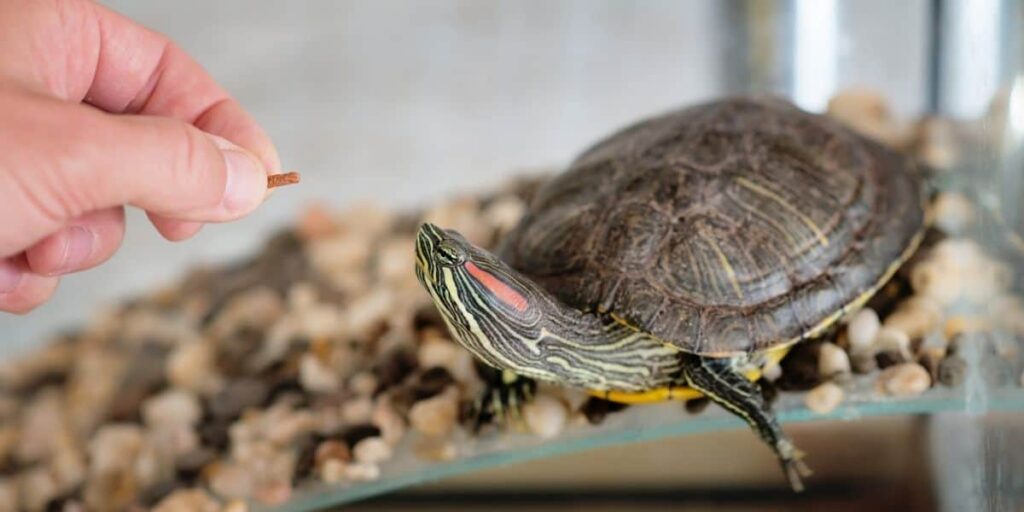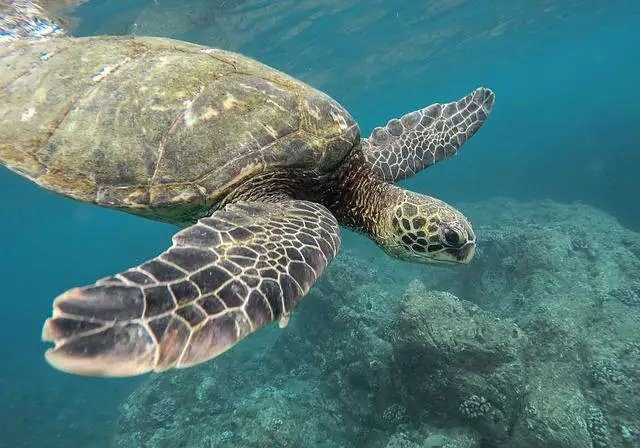One of the fascinating things about turtles is that they live so long; many will live as long as 10 – 80 years, with some more giant turtles reaching 100+ years old. This is quite an impressive feat, and it means that a pet turtle is essentially a pet for life; in quite a few cases, it will outlive its owner and be passed down to the next generation of a family member.
When you have a turtle that can live this long, it’s an owner’s primary responsibility to ensure two things; first, that the turtle is healthy and, arguably most importantly, that your turtle is happy.
It may seem like an obvious and essential point, but if your turtle is going to live such a long life, it is crucial that, as an owner, you make sure it’s the happiest life it can live. This is, of course, true for an owner of all pets, but there’s something slightly different when it comes to having the opportunity to make a pet happy for a life that could potentially last 80+ years.
How to Know If Your Turtle Is Happy
Making sure your turtle lives a happy life is one thing, but many will wonder how you can make a turtle happy and what signs you need to be aware of to indicate a turtle’s happiness.
As a reptile, they do not have some of the apparent signs you’d expect to see in a dog, and you will therefore need to be aware of some of the more individualistic and ‘discrete’ forms of happiness.
Below, we’ve listed some of the most well-known and widely researched signs that a turtle is happy (from both pet owners, vets, and scientists), and checking some of these off will go a long way to giving your pet turtle the best life possible.
Healthy
The most critical sign of a happy turtle is a healthy turtle. It’s a key consideration that we don’t try to project human emotions onto a turtle, their reptile brain does not have the same functions and needs as a human, and as long as a turtle’s basic living requirements are being met, then this essentially means that they are ‘happy.’
The key, then, is to ensure that your turtle is healthy. This involves a few basic checks, including providing the turtle has clear eyes with no weeping or swelling, breathing steadily and normally, and checking to see that they are regularly eating.
As we say, these are essential checks and requirements. Still, suppose your turtle does not demonstrate any potential health issues (cloudy or weeping eyes, no appetite, and difficulty breathing). In that case, it’s fair to assume they are comfortable and happy.
Comes to You for Food
Closely linked to your turtle’s health is regularly eating and a great way to know if your turtle is happy is if it comes to you for feeding. As you develop a bond with your turtle, it will begin to associate you positively as both the owner and provider of food.
Once a turtle feels comfortable and safe in its environment, it will come to you for food, and this is an excellent sign that your turtle is happy; it’s only when a turtle stays hidden or ignores food that you need to be concerned as this could be a sign of illness or stress.

Besides coming to you when you present food, a further sign of happiness is when a turtle begs its owner. Some water-based turtles will splash to get the owner’s attention when they enter the room, while others will move in your direction to pray.
We know that begging seems like a strange act for a turtle, but it’s one of the best signs that your turtle is both comfortable and happy in its environment, as this level of interaction with an owner shows a great degree of feeling secure in their presence.
Swimming
Swimming is natural for turtles, and not too much detail is necessary for this point. If your turtle spends adequate time in the water, either swimming or splashing, this is a good sign that it is going about its natural routine.
What we will say, however, is that providing some small fish or insects into the water can be significant mental stimulation that allows your turtle to hunt. This should be done as a treat alongside your turtle’s regular diet and is purely a way to give your turtle some mental stimulation through hunting.
Basking
When your turtle is not swimming or splashing around in the water, we’d expect to see them frequently use a basking spot. So giving your turtle a good basking spot with access to a full spectrum light is essential, and seeing your turtle use this spot is another good sign that they are acting naturally.
Basking is essential for a turtle to dry out and rest when outside the water, so make sure this area is easily accessible and comfortable. Seeing your turtle basking is an excellent sign that your turtle is happy and going about its natural routine, and many turtles can bask for up to 10 hours per day!
Exercises & Roams Freely
While we’ve mentioned that a turtle can bask for extended periods and often be seen in the water, it’s essential to ensure that they are engaging in regular exercise. If you notice that your turtle is frequently hiding and not moving about, it could be a sign of stress, fear, or illness and would need to be looked into.
Providing your turtle with a large environment to roam around is essential. A turtle in the wild will have a natural and surprisingly large territory for which it can walk, and regular exercise is a good sign of happiness.
Many owners will even let their turtle spend time roaming around outside their tank, and if they can do this freely without hiding, this is another good sign of happiness. Just make sure that when roaming outside of its tank, everyone in the household is aware and that there are no potential hazards or escape routes that could endanger your turtle.
Plays in Its Tank
Playing in its tank can mean two things in this sense, depending on what sort of environment you have provided it with. When we say play, this is linked in with the point about exercises; however, it’s more focused on your turtle doing things it would do naturally while receiving mental stimulation.
Therefore, you should create an environment that allows the turtle to swim, bask, dig, roam around, hide, climb, and even hunt. All of these are a turtle’s natural way of ‘playing.’
To take this one step further, however, you can also add toys to their tank for them to genuinely play with. This could be a ball or empty shell to push around, something that floats in the water for them to move around, or even a tiny & straightforward obstacle course for them to explore for mental stimulation.
Allow You to Pet Them
We are leaving this to last for a specific reason: not all turtles like to be handled or petted. It’s a very individualistic trait that we would not recommend forcing a turtle to try and test their happiness, as a reluctance to be petted could mean that they don’t like it or don’t feel safe.
Once you have had time to bond with your turtle and learn its behavior, you will know whether or not they like to be petted and if they do, this can be a great sign that your turtle is happy. In addition, allowing an owner to hold and pet them signifies that the turtle is relaxed in your company.
Countless pet owners find their turtle enjoys being petted, and some even like their shell to be gently stroked (we must emphasize gently as the body is susceptible); if your turtle stretches out its neck to hint at further petting, then this is one of the best signs that your turtle is enjoying it and is ultimately happy.
Round-Up
As you can see, a lot goes into ensuring a turtle’s happiness, with health being the priority. However, as far as we know, turtles do not have similar emotions to humans; therefore, to ensure a happy turtle, you should be looking to make their environment in captivity as closely related to what they would have in the wild.
Once you do this and see that your turtle is displaying typical behavior as they would in the wild, you can add other things to further enrich their lives, like toys, a more stimulating environment, and even petting (as long as your turtle likes this).
- Do Black Caiman Live in Groups? Exploring the Social Behavior of These Large Reptiles
- Do Black Caiman Have Predators? Exploring the Threats to This Amazonian Reptile
- Do Black Caiman Eat Toucans? Exploring the Diet of Black Caimans in the Wild
- Do Black Caiman Eat Sloths? The Truth About the Diet of Black Caiman
- Can a Black Caiman Kill a Human? Exploring the Predator’s Potentially Deadly Bite




